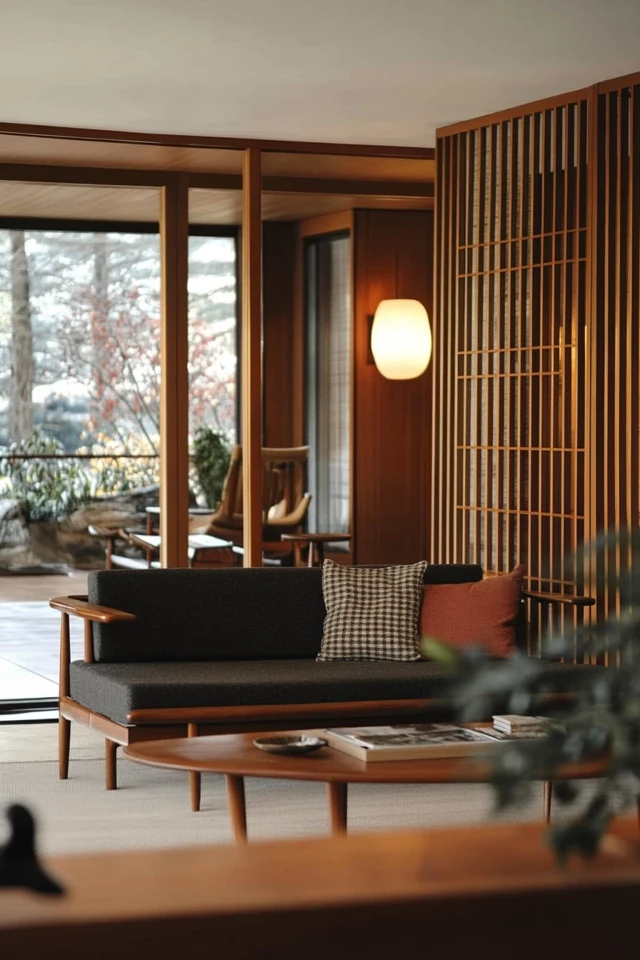Mid-century modern design is beloved for its clean lines, functional furniture, and timeless style. But what truly makes a living room inviting and dynamic is the artful combination of textures. By blending smooth, sleek materials with cozy, tactile elements, you can elevate your mid-century modern space into something that feels not only stylish but also warm and livable.
I learned this lesson when designing a mid-century inspired living room for a client. While they had nailed the essentials—a low-profile walnut sofa and a classic Noguchi coffee table—the room felt flat and uninviting. By introducing textured elements like a wool area rug, velvet throw pillows, and woven planters, the space transformed. It suddenly felt layered and alive while still maintaining its sleek, retro aesthetic.
In this guide, we’ll explore how to artfully combine textures in your mid-century modern living room for a space that’s as comfortable as it is chic.
Why Texture Matters in Mid-Century Modern Design
Texture is the secret ingredient that adds depth, warmth, and interest to a minimalist design like mid-century modern. Since this style often incorporates smooth, polished surfaces (think wood, leather, or glass), pairing them with softer, tactile materials creates balance and prevents the room from feeling too cold or stark.
1. Start With a Natural Foundation
Why It Works:
Mid-century modern design embraces natural materials like wood, leather, and stone. These elements create an organic base that you can layer textures onto.
How to Incorporate It:
- Opt for a wood coffee table or credenza in walnut, teak, or oak.
- Use a leather sofa or armchair as an anchor piece.
- Add a stone or terrazzo side table for a sleek, earthy touch.
Pro Tip: Let the natural grain and finish of these materials shine—avoid heavily lacquered or overly processed surfaces.
2. Layer Rugs for Visual Interest
Why It Works:
Rugs are an excellent way to introduce texture, color, and pattern into a mid-century modern living room. Layering rugs can create a sense of coziness and dimension.
How to Incorporate It:
- Start with a neutral, flatwoven area rug as a base.
- Layer a smaller, textured rug on top—like a shag, sheepskin, or geometric wool design.
- Choose rugs with muted tones or mid-century inspired patterns like diamonds or stripes.
Pro Tip: Keep the color palette cohesive by sticking to earthy tones or shades that complement your furniture.
3. Mix Upholstery Fabrics
Why It Works:
Combining different upholstery materials—like velvet, linen, and boucle—adds depth to your seating arrangement.
How to Incorporate It:
- Pair a sleek leather sofa with a boucle accent chair.
- Add velvet or linen throw pillows in retro colors like mustard, olive, or teal.
- Incorporate a textured pouf or ottoman for additional seating or a decorative accent.
Pro Tip: Stick to 2–3 upholstery textures to keep the look balanced and intentional.
4. Incorporate Tactile Throw Blankets and Pillows
Why It Works:
Soft, textured throws and pillows add a cozy layer to the clean lines of mid-century modern furniture.
How to Incorporate It:
- Choose throw blankets in knit, wool, or faux fur to drape over a sofa or chair.
- Mix pillows with different textures, like velvet, leather, and woven fabrics.
- Stick to geometric patterns or solid colors that complement your overall palette.
Pro Tip: Use these accessories to add pops of color or subtle patterns without overwhelming the space.
5. Play With Glass and Metal Accents
Why It Works:
Smooth materials like glass and metal provide contrast against softer textures and add a touch of mid-century sophistication.
How to Incorporate It:
- Choose a glass-topped coffee table or side table for an airy, elegant look.
- Incorporate metal lighting fixtures like brass floor lamps or black cone pendants.
- Use metallic decor elements, like a gold vase or a chrome sculpture, for subtle shine.
Pro Tip: Balance these materials with natural textures like wood or fabric to keep the space feeling grounded.
6. Add Woven Elements for Organic Texture
Why It Works:
Woven materials like rattan, cane, or seagrass bring an earthy, relaxed vibe to a mid-century modern living room.
How to Incorporate It:
- Use woven planters or baskets for functional decor.
- Choose furniture with caned detailing, like a sideboard or accent chair.
- Add a woven ottoman or pouf as a casual seating option.
Pro Tip: Pair woven elements with clean-lined furniture to maintain the mid-century aesthetic.
7. Bring in Natural Greenery
Why It Works:
Plants add life and color to a mid-century modern living room while softening harder textures like wood and glass.
How to Incorporate It:
- Choose large plants like a fiddle-leaf fig, rubber tree, or monstera deliciosa for a bold statement.
- Use mid-century modern planters with wood or metal stands.
- Group smaller plants on shelves, windowsills, or coffee tables for a layered look.
Pro Tip: Stick to simple planters in neutral or earthy tones to keep the focus on the greenery.
8. Use Geometric Patterns Sparingly
Why It Works:
Mid-century modern design loves bold geometric patterns, but using them sparingly ensures they enhance rather than overpower the space.
How to Incorporate It:
- Choose a patterned area rug or throw pillow to add visual interest.
- Opt for abstract artwork with geometric shapes or clean lines.
- Use patterned textiles in muted tones that complement the room’s palette.
Pro Tip: Balance patterns with solid, textured elements for a cohesive look.
9. Add Sculptural Decor
Why It Works:
Sculptural decor pieces add dimension and break up the clean lines of mid-century modern furniture.
How to Incorporate It:
- Choose vases, candle holders, or sculptures with interesting shapes and textures.
- Opt for materials like ceramic, wood, or stone for an organic feel.
- Use these pieces sparingly to keep the space uncluttered.
Pro Tip: Group sculptural decor in odd numbers for a balanced, visually pleasing arrangement.
10. Layer Lighting for Depth and Warmth
Why It Works:
Mid-century modern lighting often doubles as a design feature, and layering different types of lighting creates a cozy, dynamic atmosphere.
How to Incorporate It:
- Use a statement chandelier or pendant light as a focal point.
- Add floor lamps or table lamps with textured shades for softer lighting.
- Use dimmers or warm-toned bulbs to enhance the room’s cozy vibe.
Pro Tip: Stick to lighting with sleek, geometric designs or natural materials like wood or brass.
Picture Gallery
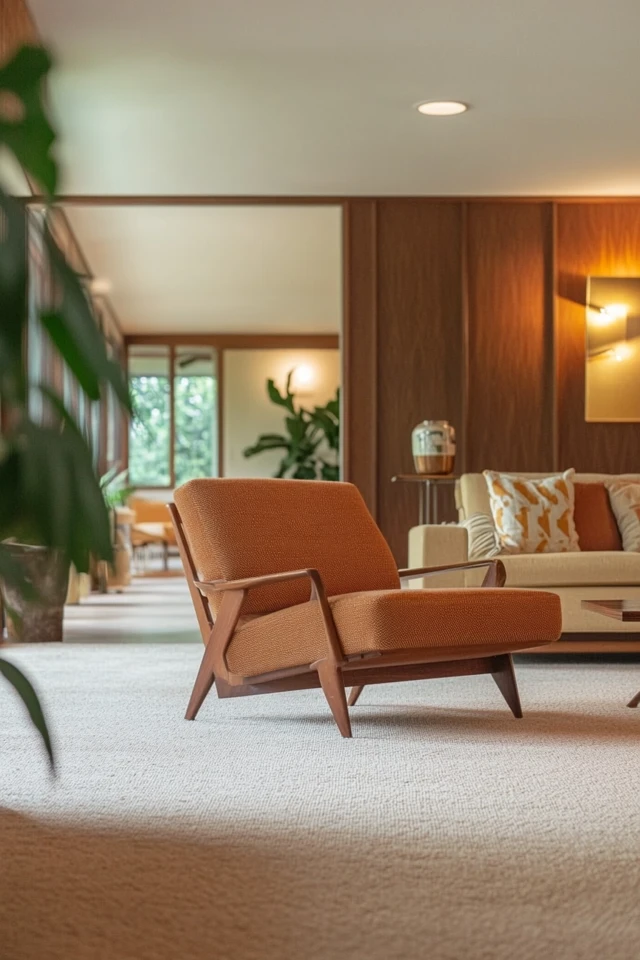
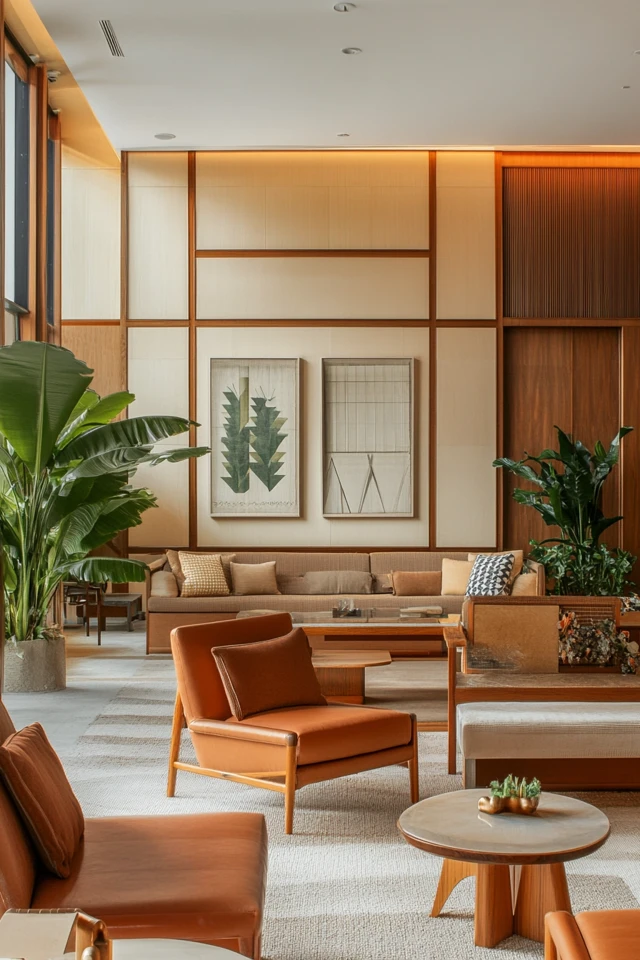
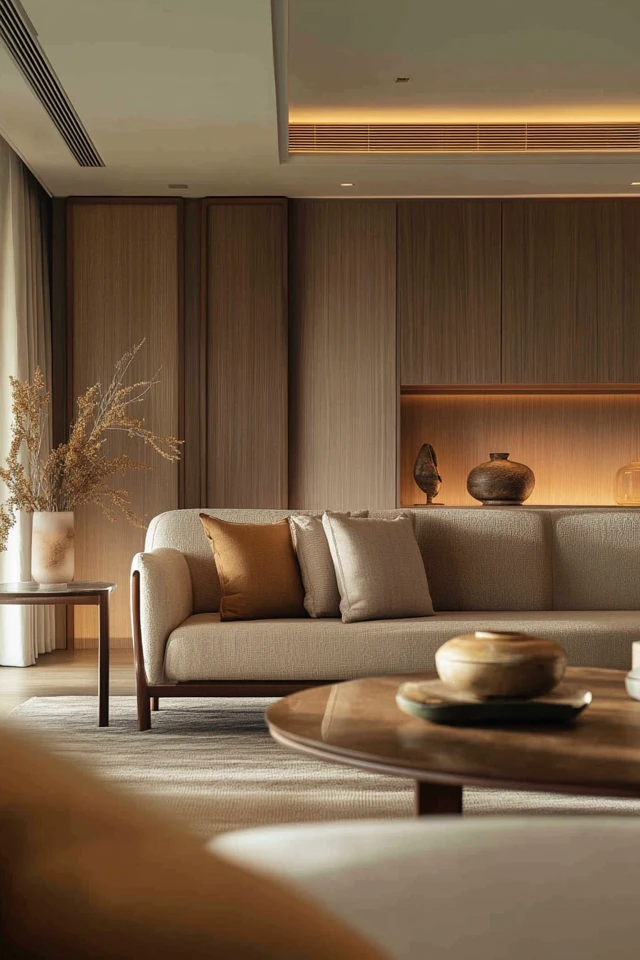
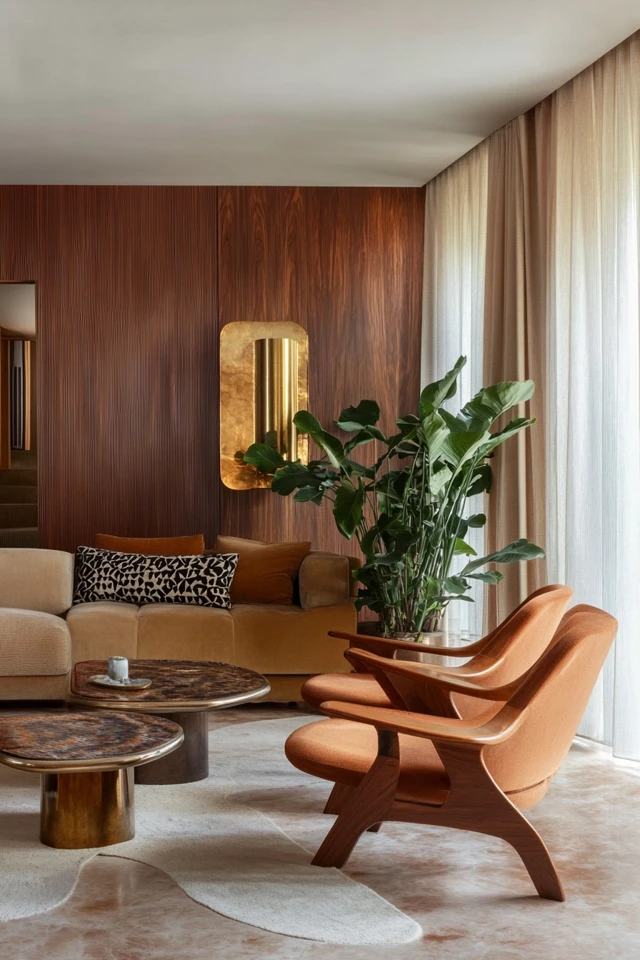
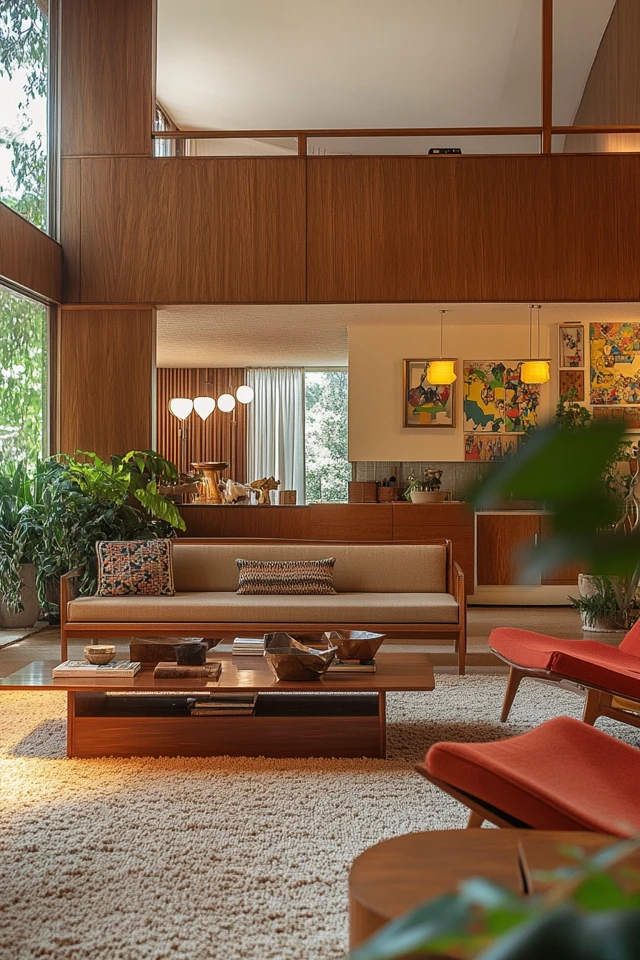

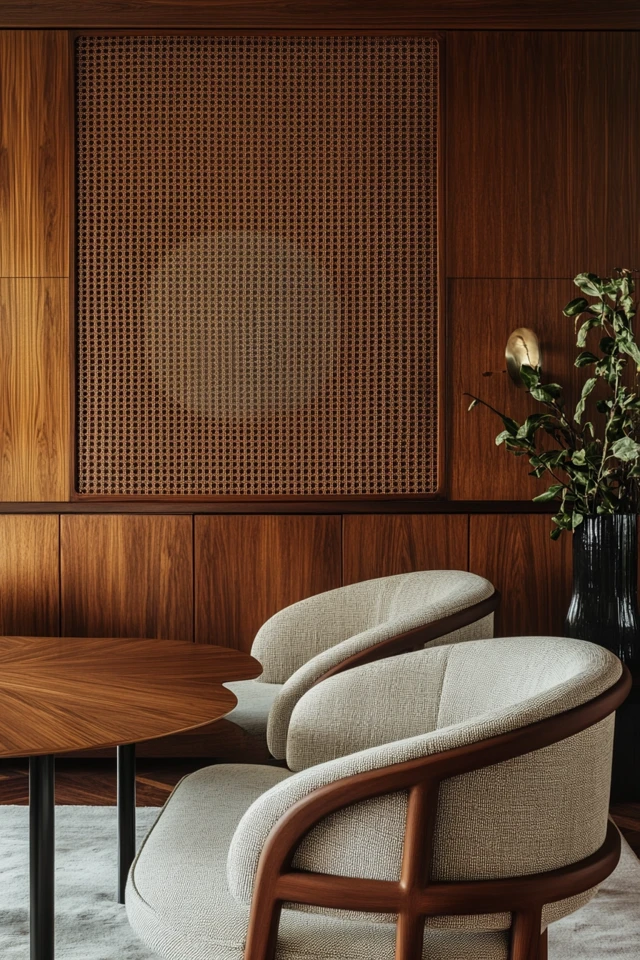

Conclusion
Combining textures in a mid-century modern living room is all about balance. By mixing smooth, polished surfaces with softer, tactile elements, you can create a space that feels layered, dynamic, and inviting. Whether you’re layering rugs, adding woven accents, or introducing cozy throw blankets, each texture plays a role in making your living room feel uniquely yours.
So go ahead—experiment with materials, add greenery, and play with patterns to bring your mid-century modern space to life. With the right mix of textures, your living room will feel like a masterpiece of retro-modern comfort and style.
FAQs
1. How many textures should I include in a mid-century modern living room?
Aim for 4–6 different textures to create depth without overwhelming the space.
2. Can I mix patterns with textures?
Yes, but keep patterns subtle and cohesive with the room’s palette. Balance them with solid, textured elements to avoid a busy look.
3. What plants work best in a mid-century modern living room?
Fiddle-leaf figs, rubber trees, snake plants, and monstera deliciosa are popular choices for their bold shapes and low-maintenance care.
4. How do I balance natural and man-made textures?
Pair organic materials like wood, wool, and rattan with sleek elements like glass, leather, and metal for a harmonious look.
5. Where can I find mid-century modern decor with great textures?
Look for textured pieces at retailers like West Elm, Article, CB2, and Etsy, or hunt for vintage finds at flea markets or thrift stores.

